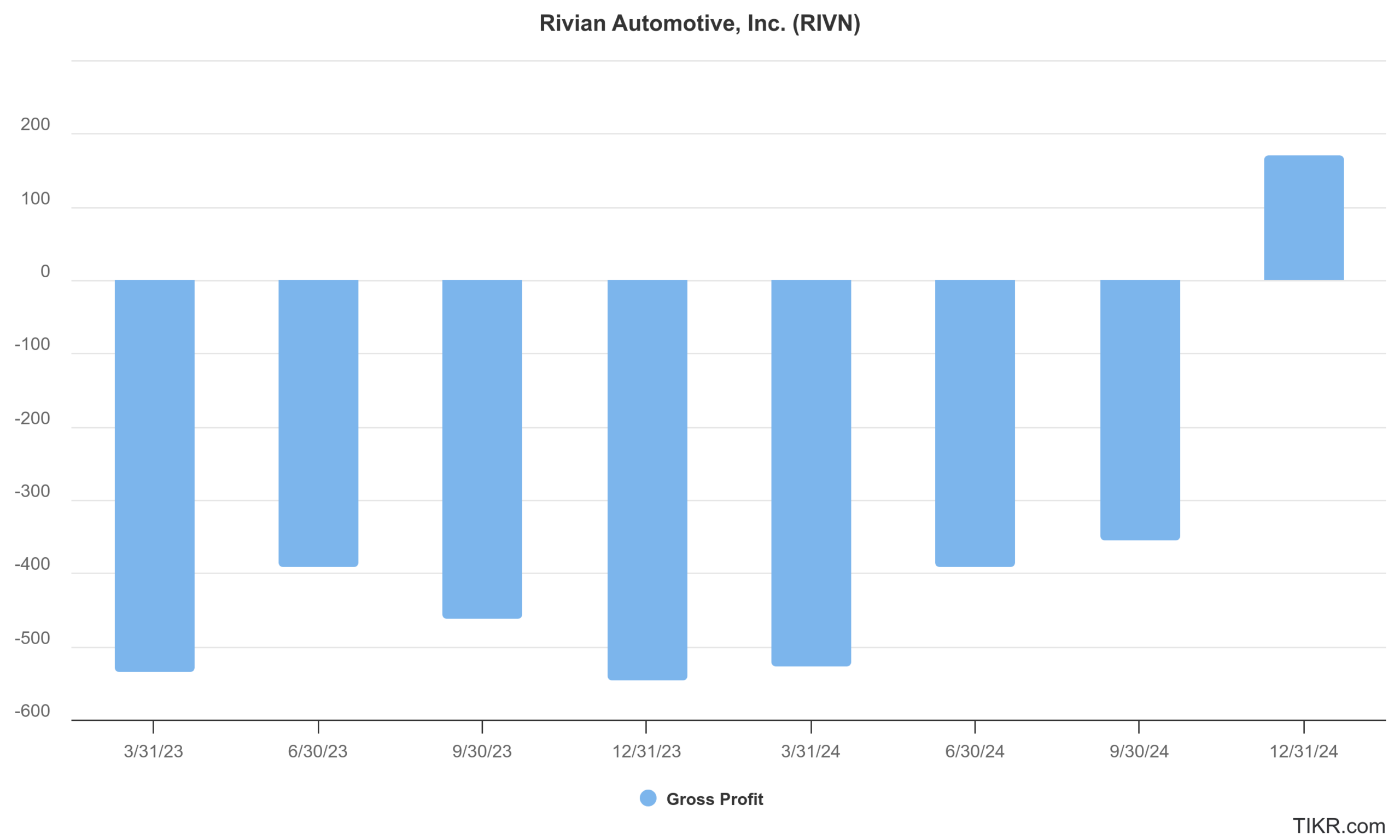Rivian Churned Out a Gross Profit in Q4 But Tepid Guidance Sours Mood
Please note that we are not authorised to provide any investment advice. The content on this page is for information purposes only.
Rivian (NYSE: RIVN) released its Q4 earnings last week and while the electric vehicle (EV) startup posted better-than-expected numbers for the quarter and churned out a gross profit as promised, its 2025 delivery guidance spooked investors and the stock closed lower following the earnings release.
Key Takeaways from RIVN’s Q4 Earnings
Rivian reported revenues of $1.73 billion in Q4 of which automotive revenues were $1.52 billion. The company recognized $299 million from sales of regulatory credits and another $214 million from sales of software and services. It generated an automotive gross profit of $110 million in the quarter while its operating loss narrowed to $661 million in Q4 as compared to $1.58 billion in the corresponding quarter in 2023.
Meanwhile, it was Rivian’s 2025 guidance that spooked investors. While the company expects its adjusted losses to narrow to between $1.7 billion to $1.9 billion as compared to $2.69 billion in 2024, it forecast deliveries between 46,000 units and 51,000 units for 2025 – below the 51,579 vehicles it delivered last year. Notably, Rivian had delivered 50,122 vehicles in 2023 and even the top end of its 2025 guidance implies this year’s deliveries to be lower than 2023 levels.
“We believe external factors could impact our 2025 expectations, including changes to government policies and regulations, and a challenging demand environment. While uncertainties persist, we remain focused on executing against our key value drivers and are confident in electrifying the world in the long term,” said Rivian’s CEO RC Scaringe in the Q4 shareholder letter.
Rivian Has Been Working on Cost Cuts
Rivian has been working on streamlining its costs which coupled with a fall in raw material prices helped the company turn the corner on profitability. The company lowered its cost of goods sold (COGS) by $31,000 between Q4 2024 and Q4 2024 which is no mean achievement and helped it lower its losses while posting a gross profit.
Along with lower costs, Rivian also benefited from higher revenues per vehicle as well as revenues from its joint venture with Volkswagen. The company also booked revenues of almost $300 million from sales of regulatory credits – a revenue stream that almost entirely flows to gross profits.
Volkswagen Invested in Rivian
Last year, Volkswagen invested in Rivian as the German auto giant continues to back EV startups. It has also invested in Chinese EV company Xpeng Motors as well as solid-state battery startup QuantumScape.
During their Q4 earnings call, Rivian said that it expects to realize revenues of $2 billion from Volkswagen over the next four years as their joint ventures deliver on the pre-set milestones. This, Rivian said would include the cash received from Volkswagen for licensing of intellectual property coupled with equity premiums and other noncash benefits.
Notably, in November Volkswagen expanded its partnership with Rivian and it would now invest $5.8 billion as compared to the $5 billion that it was previously looking for. Volkswagen invested $1.3 billion in Rivian in November and has invested a total of $2.8 billion so far. Rivian held $7.7 billion on its balance sheet at the end of December which is $1 billion higher than September.
Rivian Secured a Loan from the Department of Energy
RIVN secured a $6.6 billion loan from the US Department of Energy which coupled with the remaining commitment from Volkswagen will add another $10.1 billion to Rivian’s balance sheet. “This capital is expected to fund Rivian’s operations through the ramp of R2 in Normal, as well as R2 and R3 in Georgia, enabling a path to positive free cash flow and meaningful scale,” said RIVN CFO Claire McDonough during the Q4 earnings call.
Rivian is set to launch its low-cost platform R2 in the first half of 2026 and said that the bill of materials (BOM) for the model would be half of the R1 series of vehicles that it currently sells.
How Analysts Reacted to RIVN’s Q4 Earnings?
After Rivian’s Q4 earnings release, Cantor Fitzgerald downgraded the stock from an overweight to neutral while raising its target price by $2 to $15.
“We continue to believe that RIVN benefits from a differentiated product offering, a material commercial partnership with Amazon, and a strategic joint venture with Volkswagen. We are encouraged by the company’s first positive gross profit, albeit this was driven primarily by the sale of regulatory credits. However, we are discouraged by the company’s FY25 delivery guidance, which is lower than FY24 deliveries, and we expect fewer EDV deliveries in FY25,” said the brokerage in its report.
It added, “We are also becoming more conservative in the near term, driven by lower delivery expectations and due to macro conditions including the implementation of incremental tariffs and the likely removal of the $7,500 EV Tax Credit.”
Goldman Maintained Its Neutral Rating on Rivian
Goldman Sachs maintained its neutral rating and $14 target price on Rivian saying “While we see positive signs for the long-term, Rivian is operating in a difficult industry backdrop for EVs (including potential headwinds from a policy perspective for EV demand and credits) and guided for lower YoY vehicle shipments in 2025.”
It added, “In addition, we believe it will be important to monitor if there is a change in Rivian’s ability to capture regulatory credit revenue longer-term, which the company expects to be about flat YoY in 2025 at $300 million. Finally, we see a long path to positive FCF.”
Bernstein maintained its underperform rating on Rivian while assigning a target price of $6.10. In its report, it said, “In our view guidance for 2025 is roughly in line with expectations, but the policy uncertainty surrounding future regulatory credit sales, and disbursement of the DOE loan puts Rivian in a delicate position.”
EV Industry Turmoil
The EV industry has been going through turmoil and many startup companies in the green energy ecosystem have gone out of business – most recently Nikola which filed for bankruptcy last week. Even established names like Tesla are not immune from the slowdown and even Tesla’s deliveries fell YoY last year. While Tesla CEO Elon Musk sees delivery growth of as high as 30% this year, most analysts don’t buy the billionaire’s optimism given fears of a slowdown in the US economy.






